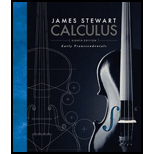
Suppose you know that
and the Taylor series of f centered at 4 converges to f(x) for all x in the interval of convergence. Show that the fifth-degree Taylor polynomial approximates f(5) with error less than 0.0002.
Want to see the full answer?
Check out a sample textbook solution
Chapter 11 Solutions
Calculus: Early Transcendentals
- The series IMR 1 (3n+2)³ is convergent. (A). According to the Remainder Estimate for the Integral Test, the error in the approximation (where a is the value of the infinite sum and a,, is the n-th partial sum) is 18-1/150 71 m (B). Find the smallest value of n such that this upper bound is less than 0.00007.arrow_forwardFind the simple continued fraction representation of (1 + sqrt6)/2 and show that it is periodic. (Do not use deciomal approximations in your proof!) Then compute the first eight convergents and find the best rational approximation with a denominator less than 30. (Justify your answer).arrow_forwardCAOUST 9 Write the Taylor Series for f(x) = sin(x) at x = 1/2/2 as p n não Cn (x-7) Find the first 5 coeffecients. 2arrow_forward
- What is the limit as x->0 of (sin(2x))/x using the Taylor series?arrow_forward7. Let (a) (b) p(x) = -1-x_ _for-1 < x < 0 +1-x for 0 < x < 1. Find the full Fourier series of p(x) in the interval (-1, 1). Find the first three nonzero terms explicitly. (c) (d) Does it converge pointwise? (e) Does it converge uniformly to p(x) in the interval (-1, 1)? Does it converge in the mean square sense? ORarrow_forwardLet f(x)=- [a] Use the definition of a Taylor Series (section 11.10 equation 6) 1 to find the Taylor Series of f about x = in sigma notation, 4 with exponents and coefficients completely simplified as shown in lecture. Find the endpoints of the interval of convergence of the series in [a]. You do not need to determine if the series converges at those endpoints. [b]arrow_forward
- Let a be a nonzero real number. For any xo satisfying 0 < x < 2/a, the recursive sequence defined by Xn+1= xn (2 Axn) — converges to some limiting value. (a) Find the value. (b) What is the order of convergence? (c) Find the asymptotic error constant.arrow_forward(4) Suppose that (sn)neN and (tn)neN are sequences and assume that (tn) converges. (a) Suppose that there exists a constant C> 0 such that sn - Sm| ≤ Ctn - tm for all n, me N. Prove that (sn) converges. (b) Let tn = Then (tn) converges. Give an example of a sequence (sn) that tn+1 for all n. does not converge for which sn - Sn+1 ≤ |tn -arrow_forwardf(x)=(3x+1) . a] Find the Taylor series expansion associated with f centered at 2.b] What is the largest interval on which the Taylor series expansion associated with f converges back to the function. Justify your answer as clearly as you can.arrow_forward
- Compute the Fourier series for the given function on the specified interval. Use a computer of graphing calculator to plot a few partial sums of the Fourier series. f (x) = 0arrow_forwardConsider the function F(x) = sint di (a) Show that F(x) = x - 3-3! + کر 5.5! x7 7.7! 00 +... (b) Write F(1) as an infinite series an and find the smallest value N such that the partial sum Sy n=0 approximates F(1) with an error less than 0.0001.arrow_forwardarrow_back_iosarrow_forward_ios
 Calculus: Early TranscendentalsCalculusISBN:9781285741550Author:James StewartPublisher:Cengage Learning
Calculus: Early TranscendentalsCalculusISBN:9781285741550Author:James StewartPublisher:Cengage Learning Thomas' Calculus (14th Edition)CalculusISBN:9780134438986Author:Joel R. Hass, Christopher E. Heil, Maurice D. WeirPublisher:PEARSON
Thomas' Calculus (14th Edition)CalculusISBN:9780134438986Author:Joel R. Hass, Christopher E. Heil, Maurice D. WeirPublisher:PEARSON Calculus: Early Transcendentals (3rd Edition)CalculusISBN:9780134763644Author:William L. Briggs, Lyle Cochran, Bernard Gillett, Eric SchulzPublisher:PEARSON
Calculus: Early Transcendentals (3rd Edition)CalculusISBN:9780134763644Author:William L. Briggs, Lyle Cochran, Bernard Gillett, Eric SchulzPublisher:PEARSON Calculus: Early TranscendentalsCalculusISBN:9781319050740Author:Jon Rogawski, Colin Adams, Robert FranzosaPublisher:W. H. Freeman
Calculus: Early TranscendentalsCalculusISBN:9781319050740Author:Jon Rogawski, Colin Adams, Robert FranzosaPublisher:W. H. Freeman
 Calculus: Early Transcendental FunctionsCalculusISBN:9781337552516Author:Ron Larson, Bruce H. EdwardsPublisher:Cengage Learning
Calculus: Early Transcendental FunctionsCalculusISBN:9781337552516Author:Ron Larson, Bruce H. EdwardsPublisher:Cengage Learning





